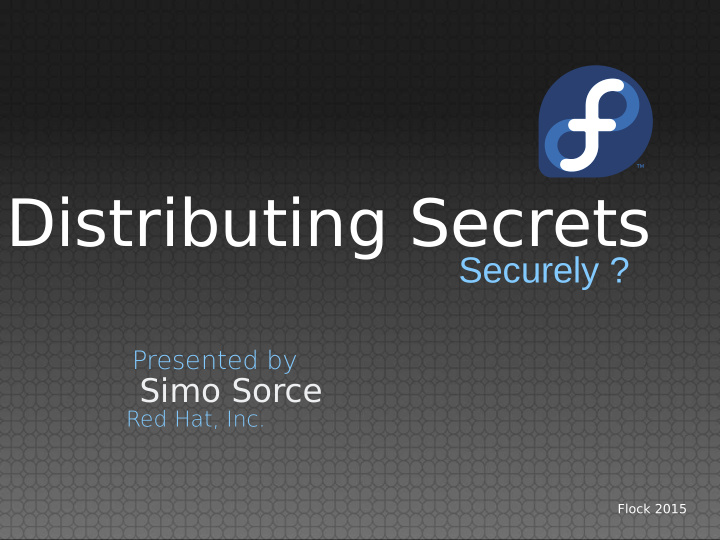



Distributing Secrets Securely ? Presented by Simo Sorce Red Hat, Inc. Flock 2015
Historically Monolithic applications on single servers potentially hooked to a central authentication system. Idm
Distributing Secrets ? Containers… it's all their fault! :-) Not really, most distributed systems need credentials to access resources like databases or 3 rd party APIs
Clouds, microservices Distributed applications multi-tier services, 3 rd party services, clouds...
What happens today? Provisioning systems like puppet and ansible are used to distribute data, storing credentials in the clear somewhere and pushing them around to various hosts. Some people even bake credentials directly in container images or keep them in some version control system directly accessible by images …
Secrets != confjguration Confjguration in many cases can be public information and it is rarely an issue if it get disclosed [ security through obscurity? ] Secrets are never public, and should be treated difgerently from the rest.
Let's defjne the problem space What is that we really need to do with secrets and passwords ? And what options we have ? 5 things we care for: PUPPA Provide, Update, Preserve, Protect, Audit On the following slide: P = provisioning copies of secrets in fjles A = Use of an API to retrieve secrets
Provide How do I get a secret for a specifjc service to a specifjc application ? P) Push secret into application confjg fjles from some place that stores them A) Make the application (or helper) pull the secrets as needed
Update How do I update a secret in all applications when needed ? P) Push secrets again and/or restart application/container A) 1. Notify application 2. Application pulls the new secret
Preserve How do I preserve correct credentials when a container image is rebuilt ? P) Keep side volume with credentials stored there “in the clear” or inject at every startup A) Let applications pull their secrets
Protect How do I limit access to these credentials exclusively to what needs them ? P) Trust the provisioning system and all the people involved to get it right. A) Store secrets encrypted, use Access Controls to limit who gets what.
Audit How do I know who got secrets ? P) Add auditing capabilities throughout the whole infrastructure. (LAUGHS) A) Store secrets encrypted, audit who access what at retrieval time.
But wait ... … how do I authenticate to an API if I do not have credentials ?
That's a GREAT question!
Trusting the Host ? The host itself is trusted by the applications it runs, containers and VMs included. Conversely, applications running on the host are (ideally) not trusted. The host is critical to address bootstrapping issues, and will have to be provisioned accordingly. Give hosts an identity (a x509 cert, a keytab, a password) and a role when provisioning.
Example use case Trying to get FreeIPA domain controllers installed in an automated way. Bootstrapping the installation is problematic, as there is a need to transfer passwords, keys, certifjcates from one server to another. Traditionally done manually by preparing and transferring an encrypted install fjle. Does not scale well in a dynamic environment.
What's hard about it ? Some of these keys change over time, others are created over time, so we cannot just keep a copy “somewhere” We needed: A way to fetch a set of credentials from an existing server over the network A secure method to transfer those keys over the wire A way to authorize access to those keys
What do I need ? An API and service to distribute secrets Can encrypt information at rest and in transit Provides a useful REST API to access/store data Modular design allow to confjgure authentication/authorization and storage methods including proxying requests to other services.
Custodia Built in Python Simple HTTP server, can listen on a unix socket and served via a proxy (Apache) Uses jwcrypto to implement the JOSE standard for web encryption (uses python-cryptography for crypto ops) Very easy to extend (see ipakeys)
Works as a Pipeline The path used to fetch a secret can be munged and composed by intermediaries GET https://srv1/secrets/foo/bar GET https://my.custodia.net/secrets/remote1/foo/bar Client Custodia Remote1 AUTHORIZE remote1 FOR bar; SELECT bar WHERE user IS foo; Custodia Core1 Secrets Database
Transferring secrets ... Simple type (use over TLS, please!): Retrieve a secret: → GET /secrets/test/mypassword ← 200 OK {type: simple, value: “secret” } Store a secret: → PUT /secrets/test/mypassword {type: simple, value: “secret” } ← 201 OK
… with signing ... Retrieve using Key Exchange Message: → GET /secrets/three/levels/down/mysecret? type=kem&value=aaaaaa.bbbbbb.cccccc aaaaaa.bbbbbb.cccccc == Encoded { "protected": { "kid": <public-key-dentifjer>, Header "alg": <valid alg name> }, "claims": { "sub": “mysecret”, Payload "exp": <expiration time>, "value": <arbitrary> }, Signature "signature": "ABCDEFGHIJKLMNOPQRSTUVXYZ" }
… and sealing ... Retrieve using Key Exchange Message: ← 200 OK aaaaa.bbbbb.ccccc.ddddd.eeeee == { "protected": { "kid": <public-key-dentifjer>, Header "alg": <valid alg name>, "enc": <valid enc type> }, "encrypted_key": <JWE Encrypted Key>, JWE fjelds "iv": <Initialization Vector>, "ciphertext": <Encrypted JWS token>, Payload "tag": <Authentication T ag> JWE fjelds }
Accessing Custodia Authentication is normally done via tokens in headers, fully pluggable, determined by confjguration statements Example Authentication directive: [auth:header] handler = custodia.httpd.authenticators.SimpleHeaderAuth name = REMOTE_USER Example Authorization directive: [authz:kemkeys] handler = ipakeys.kem.IPAKEMKey paths = /keys store = ipa server_keys = /etc/ipa/custodia/server.keys
Within FreeIPA 1. Admin stores new server's Public Keys in LDAP [Provisioning step] LDAP 3. Custodia fetches Public Keys and Authorizes based 2. New replica sends signed on data in LDAP Custodia request for keys 4. Custodia sends back signed and encrypted reply with keys
Questions ? Contact: simo@redhat.com
Recommend
More recommend